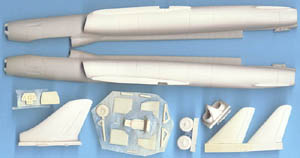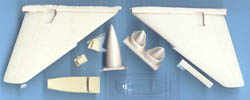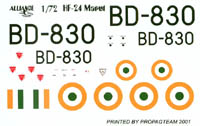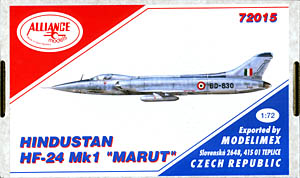Alliance Models' 1/72 Hindustan HF-24
Marut Mk. 1 | | History After the Second World War German aircraft designers found themselves relocating around the world. One of the most famous designers to come out of Germany was Kurt Tank, who ended up in India. There he led a design team to develop India's first fighter. The Marut (Wind Spirit) first flew on June 17, 1961, with the first planes entering service in 1968. The initial version has a pair of Rolls Royce Orpheus engines, pushing the plane to a top speed of Mach 1.02 at 40,000ft. It was a fuel-hungry plane, though, with a radius of action roughly 400 miles. Armament was potent, with four 30mm cannons in the nose and the ability to carry a variety of weapons on four wing stations. The Marut may not have been the best performer in the late 1960s but it did give India good experience in building long-lasting aircraft, as the last HF-24 left service in 1985. Over one hundred were built, including a dozen two-seat trainers.  The Kit The Kit
There are not many choices out there if you want to build a Marut in 1/72. In fact, I believe this is the only resin kit of this plane, and possibly even the only kit period. You get a handful of tan resin parts with a fairly conventional construction breakdown. The fuselage is split into right and left halves, with a separate nose and exhaust tailpiece as well as separate air intakes. The surface detailing is decent, although some of the panel lines will need some cleanup work. Inside the fuselage there's a basic cockpit consisting of a floor (which also makes up the nose gear well), seat, instrument panel, and rear bulkhead. There's notes in the instructions stating that you need 9 grams of weight ahead of the cockpit and 9 grams behind, which sounds about right considering how much solid resin is going to end up behind the main wheels.  The wings are molded as one piece for the right and left sides. There's one small failing here, though, in that one wing is noticably thicker than the other. In looking at them from the front, one tapers and one doesn't. Some careful work with some sandpaper will fix this, although you'll have to rescribe the panel line detail. The landing gear is basic but looks to be strong enough to hold the finished model. For those that are worried about it, though, some simple brass replacements would be easy to set up. The wheels are nicely done with excellent detailing. The only thing that definitely needs to be replaced are the gear doors, which are just too thick to be realistic. Some sheet styrene or even brass will yield up much more realistic results, and you can use the kit parts as templates. The wings are molded as one piece for the right and left sides. There's one small failing here, though, in that one wing is noticably thicker than the other. In looking at them from the front, one tapers and one doesn't. Some careful work with some sandpaper will fix this, although you'll have to rescribe the panel line detail. The landing gear is basic but looks to be strong enough to hold the finished model. For those that are worried about it, though, some simple brass replacements would be easy to set up. The wheels are nicely done with excellent detailing. The only thing that definitely needs to be replaced are the gear doors, which are just too thick to be realistic. Some sheet styrene or even brass will yield up much more realistic results, and you can use the kit parts as templates.
 The decal sheet is very nicely done and provides markings for one HF-24. No unit information is provided, and it doesn't appear like there's any unit markings applied. Aside from the roundels the only other identifying marks are the serial numbers on the fuselage & wing. The decals are printed by Propagteam and are well printed, with the saffron color matching photos almost exactly. The finish of all Maruts was natural metal, so you'll probably want to try out some Alclad II on this one. The decal sheet is very nicely done and provides markings for one HF-24. No unit information is provided, and it doesn't appear like there's any unit markings applied. Aside from the roundels the only other identifying marks are the serial numbers on the fuselage & wing. The decals are printed by Propagteam and are well printed, with the saffron color matching photos almost exactly. The finish of all Maruts was natural metal, so you'll probably want to try out some Alclad II on this one.
Conclusion Indian aircraft aren't exactly the most common of modeling subjects (other than those that were popular in their original countries, like the Sea Harrier) and this kit definitely fills a hole in Indian Air Force aircraft. While building this kit won't be a weekend project, it does a great job of capturing the shape of this unique aircraft and will look great sitting next to an Indian MiG-21. | 


 




|
